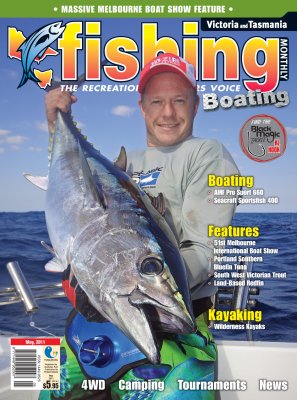Luring redfin from the Bank by Robbie Alexander
 Redfin perch, or English perch as they are otherwise known, were introduced into Australia way back in the late 1800s, but their impact wasn't really felt until the mid 1900s when the population really started to boom.
Redfin perch, or English perch as they are otherwise known, were introduced into Australia way back in the late 1800s, but their impact wasn't really felt until the mid 1900s when the population really started to boom.
They started spreading rapidly and really acclimatised in well. In fact, they've settled in a little too well, and are now a declared noxious species in some states such as New South Wales and Tasmania.
Many people don't like redfin because of the detrimental effects they have on our native fish, in particular the endangered Macquarie perch which inhabit areas similar to redfin. Macquarie perch are not anywhere near as prolific a breeder as the redfin, and when they do breed, the predatory nature of the redfin usually means Macquarie perch fry are consumed very quickly after they are born.
Redfin also harbour a disease called EHN (Epizootic Haematopoietic Necrosis) which is a viral disease that is unique to Australia, and can cause high mortalities in juvenile redfin, but worst of all our native fish are susceptible to this virus, and in particular the endangered Macquarie perch.
So there are the bad points of redfin, and I'm sure if they had not been imported from Europe by now, they certainly never would be. However the fact is that they will be here forever, so enjoy catching them and focus on their good points like their amazing ability to bounce back from the dead thanks to their high fertility and ability to breed very prolifically.
TACKLE
When targeting redfin from the bank of a lake, river or small stream, lightweight gear very similar to what you would use for trout is the best.
If your just starting out, or not wanting to spend huge amounts, Shimano and Daiwa both have very well priced lightweight spinning reels in the $40-$50 price range that will suit most anglers and certainly do the job, and there is a whole plethora of lightweight rods on the markets these days.
I personally avoid braided line for my redfin rods. Many people use, and swear by braided line however I find that the fine braided lines are more prone to tangles when spinning with bladed spinners than monofilament lines. I use braided line on my overhead reels, but with my little eggbeaters, I much prefer mono. That's a personal choice, and no doubt many people would not agree.
HARDBODIED LURES
Redfin are not known as fussy fish, and will usually hit just about any lure that moves past them, from jaggers and ice jigs, to the good old-fashioned hogback.
When casting from the bank in lakes I prefer to use blades such as the Damiki Vault or Koolabung blades for redfin, as they are heavy and cast a long way, and also sink quickly if you need them too. Blades vibrate and shimmer as they move through the water, and attract redfin from a long way away.
If I'm finding the blades are not working as well as I would like, I will switch over to a small bladed spinner. My favourite bladed spinner for redfin is the Super Vibrax, made by Blue Fox. The Super Vibrax spinners are heavier than most bladed spinners in their size range, therefore cast further. Another big plus for the Super Vibrax is that they are a very reliable spinner, and when you open a new packet and tie on your new Super Vibrax, you know it will spin well.
Bladed spinners are also very good when chasing redfin in smaller waterways, such as small streams, where a blade might be just a bit too big and intrusive.
Small hardbodied lures are also a dynamite type to use for redfin, especially for the larger redfin. I recently caught a 1kg redfin in a small stream on a Pontooo